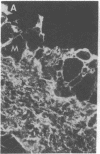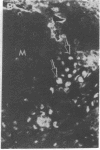Abstract
The biosynthesis of fibronectin during the in vivo development of matrix-induced endochondral bone was investigated by using [35S]methionine in rats. The dmineralized bone matrix that was implanted subcutaneously to induce local bone formation bound circulating fibronectin. This may be an important initial requirement for cell attachment to the matrix. Fibronectin was present throughout the development of bone but accounted for the largest percentage of total protein synthesized during mesenchymal cell proliferation and hematopoiesis. Fibronectin was identified in tissue extracts by its (i) comigration on electrophoretic NaDodSO4/polyacrylamide gels with human and rat plasma fibronectin, (ii) affinity for denatured collagen, (iii) crossreactivity with purified antibody of rat plasma fibronectin, and (iv) insensitivity to collagenase digestion. Fibronectin was localized by immunofluorescence in the extracellular matrix during the period of mesenchymal cell proliferation. During chondrogenesis, fibronectin was demonstrated in the differentiating chondrocytes. Fibronectin was detectable in the cartilage matrix only after hyaluronidase treatment. During vascular invasion, prior to osteogenesis, fibronectin was localized in association with endothelial cells. These observations demonstrate a possible role of fibronectin in collagenous matrix-mesenchymal cell interaction in vivo.
Full text
PDF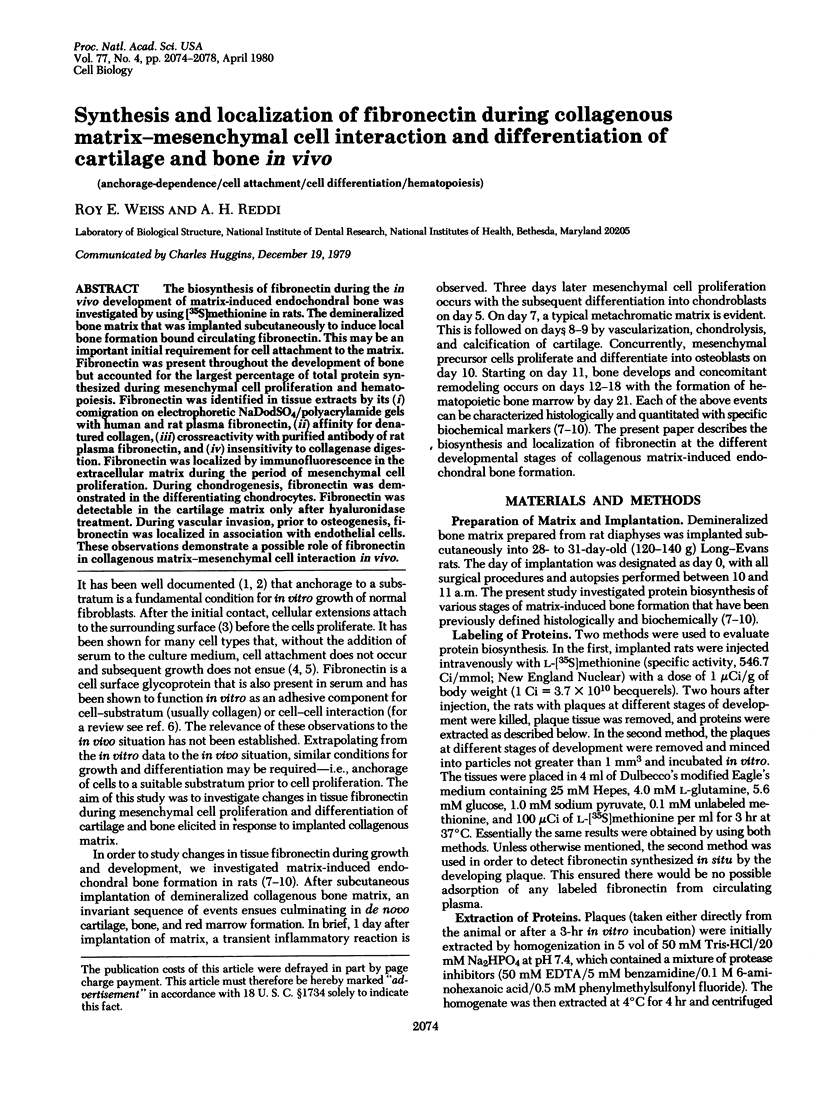
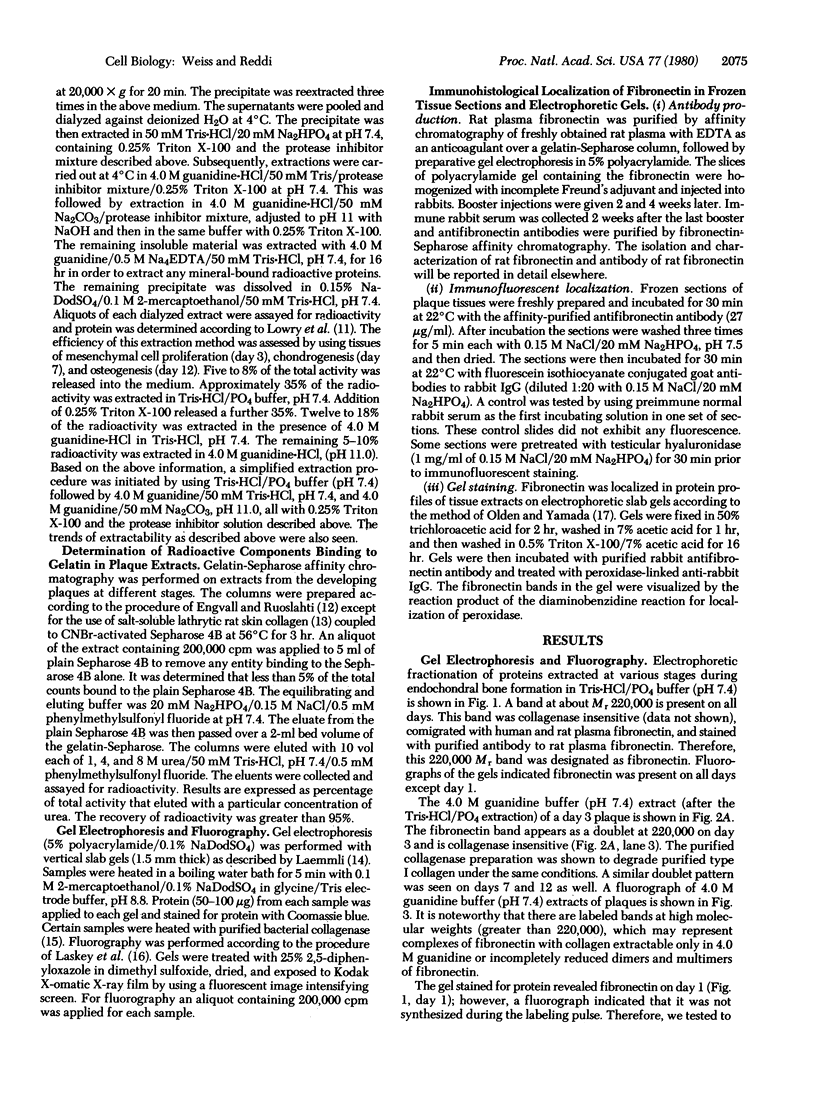

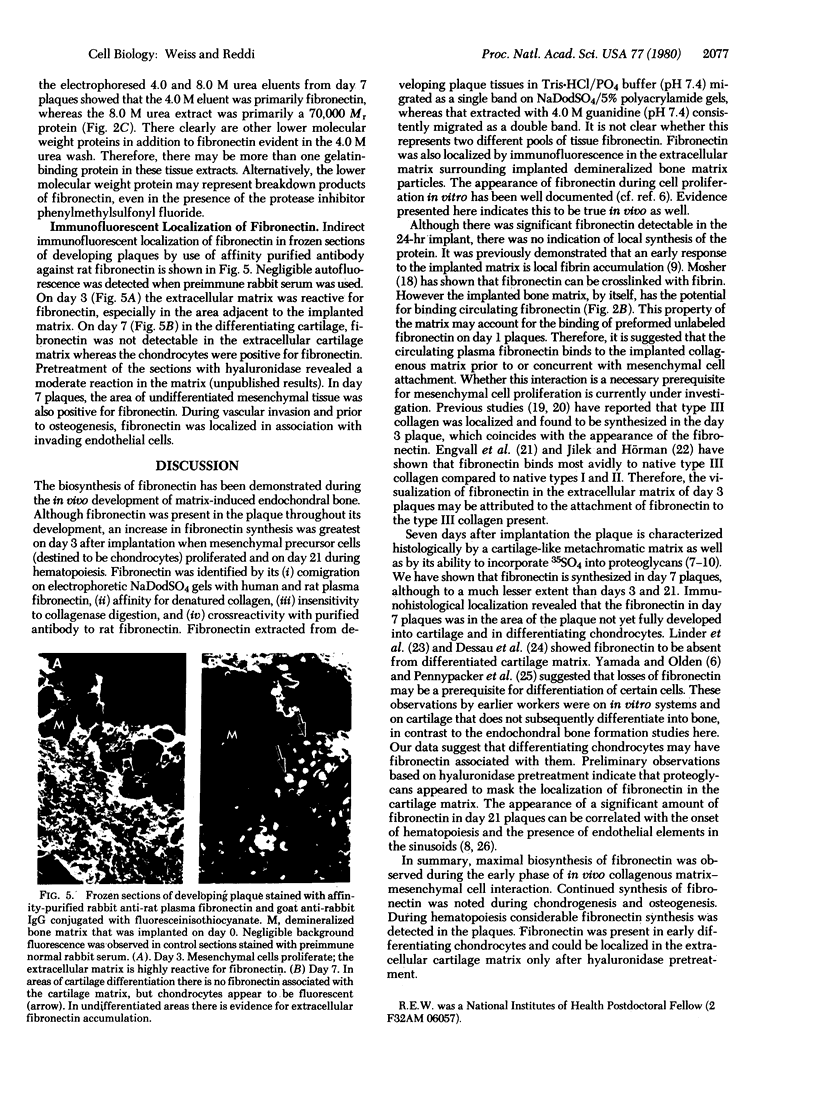
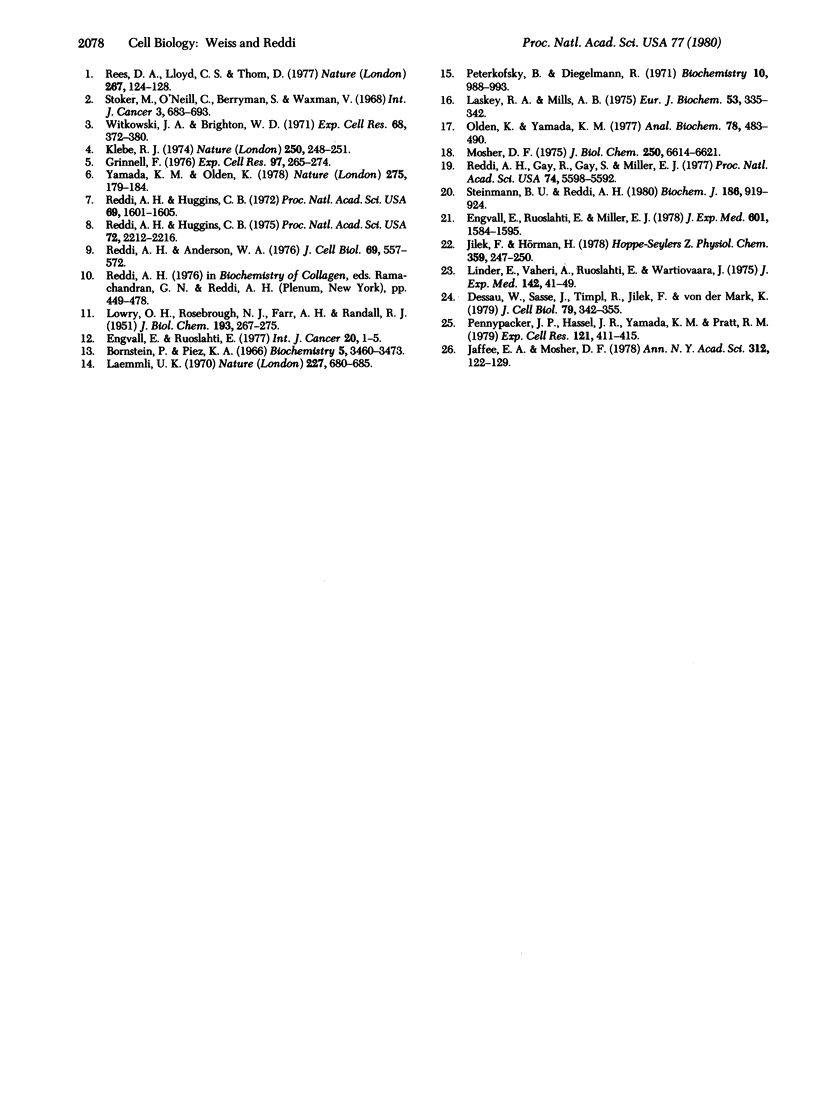
Images in this article
Selected References
These references are in PubMed. This may not be the complete list of references from this article.
- Bornstein P., Piez K. A. The nature of the intramolecular cross-links in collagen. The separation and characterization of peptides from the cross-link region of rat skin collagen. Biochemistry. 1966 Nov;5(11):3460–3473. doi: 10.1021/bi00875a012. [DOI] [PubMed] [Google Scholar]
- Dessau W., Sasse J., Timpl R., Jilek F., von der Mark K. Synthesis and extracellular deposition of fibronectin in chondrocyte cultures. Response to the removal of extracellular cartilage matrix. J Cell Biol. 1978 Nov;79(2 Pt 1):342–355. doi: 10.1083/jcb.79.2.342. [DOI] [PMC free article] [PubMed] [Google Scholar]
- Engvall E., Ruoslahti E. Binding of soluble form of fibroblast surface protein, fibronectin, to collagen. Int J Cancer. 1977 Jul 15;20(1):1–5. doi: 10.1002/ijc.2910200102. [DOI] [PubMed] [Google Scholar]
- Engvall E., Ruoslahti E., Miller E. J. Affinity of fibronectin to collagens of different genetic types and to fibrinogen. J Exp Med. 1978 Jun 1;147(6):1584–1595. doi: 10.1084/jem.147.6.1584. [DOI] [PMC free article] [PubMed] [Google Scholar]
- Grinnell F. The serum dependence of baby hamster kidney cell attachment to a substratum. Exp Cell Res. 1976 Feb;97(2):265–274. doi: 10.1016/0014-4827(76)90616-9. [DOI] [PubMed] [Google Scholar]
- Jaffe E. A., Mosher D. F. Synthesis of fibronectin by cultured human endothelial cells. Ann N Y Acad Sci. 1978 Jun 20;312:122–131. doi: 10.1111/j.1749-6632.1978.tb16797.x. [DOI] [PubMed] [Google Scholar]
- Jilek F., Hörmann H. Cold-insoluble globulin (fibronectin), IV[1-35 affinity to soluble collagen of various types. Hoppe Seylers Z Physiol Chem. 1978 Feb;359(2):247–250. doi: 10.1515/bchm.1978.359.1.247. [DOI] [PubMed] [Google Scholar]
- Klebe R. J. Isolation of a collagen-dependent cell attachment factor. Nature. 1974 Jul 19;250(463):248–251. doi: 10.1038/250248a0. [DOI] [PubMed] [Google Scholar]
- LOWRY O. H., ROSEBROUGH N. J., FARR A. L., RANDALL R. J. Protein measurement with the Folin phenol reagent. J Biol Chem. 1951 Nov;193(1):265–275. [PubMed] [Google Scholar]
- Laemmli U. K. Cleavage of structural proteins during the assembly of the head of bacteriophage T4. Nature. 1970 Aug 15;227(5259):680–685. doi: 10.1038/227680a0. [DOI] [PubMed] [Google Scholar]
- Laskey R. A., Mills A. D. Quantitative film detection of 3H and 14C in polyacrylamide gels by fluorography. Eur J Biochem. 1975 Aug 15;56(2):335–341. doi: 10.1111/j.1432-1033.1975.tb02238.x. [DOI] [PubMed] [Google Scholar]
- Linder E., Vaheri A., Ruoslahti E., Wartiovaara J. Distribution of fibroblast surface antigen in the developing chick embryo. J Exp Med. 1975 Jul 1;142(1):41–49. doi: 10.1084/jem.142.1.41. [DOI] [PMC free article] [PubMed] [Google Scholar]
- Mosher D. F. Cross-linking of cold-insoluble globulin by fibrin-stabilizing factor. J Biol Chem. 1975 Aug 25;250(16):6614–6621. [PubMed] [Google Scholar]
- Olden K., Yamada K. M. Direct detection of antigens in sodium dodecyl sulfate-polyacrylamide gels. Anal Biochem. 1977 Apr;78(2):483–490. doi: 10.1016/0003-2697(77)90108-7. [DOI] [PubMed] [Google Scholar]
- Pennypacker J. P., Hassell J. R., Yamada K. M., Pratt R. M. The influence of an adhesive cell surface protein on chondrogenic expression in vitro. Exp Cell Res. 1979 Jul;121(2):411–415. doi: 10.1016/0014-4827(79)90022-3. [DOI] [PubMed] [Google Scholar]
- Peterkofsky B., Diegelmann R. Use of a mixture of proteinase-free collagenases for the specific assay of radioactive collagen in the presence of other proteins. Biochemistry. 1971 Mar 16;10(6):988–994. doi: 10.1021/bi00782a009. [DOI] [PubMed] [Google Scholar]
- Reddi A. H., Anderson W. A. Collagenous bone matrix-induced endochondral ossification hemopoiesis. J Cell Biol. 1976 Jun;69(3):557–572. doi: 10.1083/jcb.69.3.557. [DOI] [PMC free article] [PubMed] [Google Scholar]
- Reddi A. H., Gay R., Gay S., Miller E. J. Transitions in collagen types during matrix-induced cartilage, bone, and bone marrow formation. Proc Natl Acad Sci U S A. 1977 Dec;74(12):5589–5592. doi: 10.1073/pnas.74.12.5589. [DOI] [PMC free article] [PubMed] [Google Scholar]
- Reddi A. H., Huggins C. B. Formation of bone marrow in fibroblast-transformation ossicles. Proc Natl Acad Sci U S A. 1975 Jun;72(6):2212–2216. doi: 10.1073/pnas.72.6.2212. [DOI] [PMC free article] [PubMed] [Google Scholar]
- Reddi A. H., Huggins C. Biochemical sequences in the transformation of normal fibroblasts in adolescent rats. Proc Natl Acad Sci U S A. 1972 Jun;69(6):1601–1605. doi: 10.1073/pnas.69.6.1601. [DOI] [PMC free article] [PubMed] [Google Scholar]
- Rees D. A., Lloyd C. W., Thom D. Control of grip and stick in cell adhesion through lateral relationships of membrane glycoproteins. Nature. 1977 May 12;267(5607):124–128. doi: 10.1038/267124a0. [DOI] [PubMed] [Google Scholar]
- Steinmann B. U., Reddi A. H. Changes in synthesis of types-I and -III collagen during matrix-induced endochondral bone differentiation in rat. Biochem J. 1980 Mar 15;186(3):919–924. doi: 10.1042/bj1860919. [DOI] [PMC free article] [PubMed] [Google Scholar]
- Stoker M., O'Neill C., Berryman S., Waxman V. Anchorage and growth regulation in normal and virus-transformed cells. Int J Cancer. 1968 Sep 15;3(5):683–693. doi: 10.1002/ijc.2910030517. [DOI] [PubMed] [Google Scholar]
- Witkowski J. A., Brighton W. D. Stages of spreading of human diploid cells on glass surfaces. Exp Cell Res. 1971 Oct;68(2):372–380. doi: 10.1016/0014-4827(71)90162-5. [DOI] [PubMed] [Google Scholar]
- Yamada K. M., Olden K. Fibronectins--adhesive glycoproteins of cell surface and blood. Nature. 1978 Sep 21;275(5677):179–184. doi: 10.1038/275179a0. [DOI] [PubMed] [Google Scholar]






